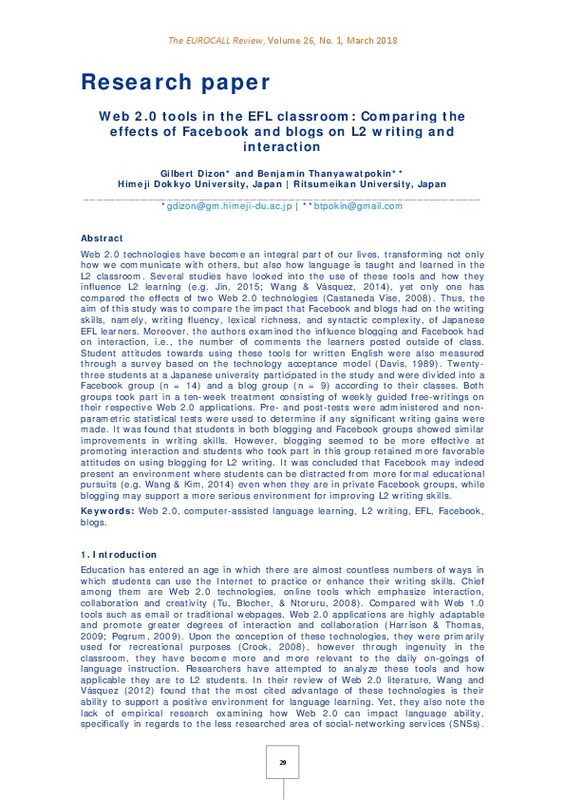Alm, A. (2015). Facebook for informal language learning. EUROCALL Review, 23(2), 3-18. Retrieved from http://polipapers.upv.es/index.php/eurocall/article/view/4665/4791
Amir, Z., Ismail, K., Hussin, S. (2011). Blogs in language Learning: Maximizing Students' Collaborative Writing. Procedia Social and Behavioral Sciences, 18, 537-543. doi: 10.1016/j.sbspro.2011.05.079
Browne, C. (2013). The new general service list: Celebrating 60 years of vocabulary learning. The Language Teacher, 37(4), 13-16.
[+]
Alm, A. (2015). Facebook for informal language learning. EUROCALL Review, 23(2), 3-18. Retrieved from http://polipapers.upv.es/index.php/eurocall/article/view/4665/4791
Amir, Z., Ismail, K., Hussin, S. (2011). Blogs in language Learning: Maximizing Students' Collaborative Writing. Procedia Social and Behavioral Sciences, 18, 537-543. doi: 10.1016/j.sbspro.2011.05.079
Browne, C. (2013). The new general service list: Celebrating 60 years of vocabulary learning. The Language Teacher, 37(4), 13-16.
Castaneda Vise, D. A. (2008). The effects of wiki- and blog-technologies on the students' performance when learning the preterit and imperfect aspects in Spanish. Dissertation Abstracts International: Section A. The Humanities and Social Sciences, 69 (01), 0187.
Crook, C. (2008). Web 2.0 Technologies for Learning: The Current Landscape - Opportunities, Challenges and Tensions. Retrieved fromhttp://dera.ioe.ac.uk/1474/1/becta_2008_web2_currentlandscape_litrev.pdf
Davis, F. D. (1989). Perceived usefulness, perceived ease of use, and user acceptance of information technology. MIS Quarterly, 13(3), 319-340. Retrieved from jstor.org/stable/249008
Dizon, G. (2016). A comparative study of Facebook vs. paper-and-pencil writing to improve L2 writing skills. Computer Assisted Language Learning, 29(8), 1249-1258. doi: 10.1080/09588221.2016.1266369
Fellner, T., Apple, M. (2006). Developing writing fluency and lexical complexity with blogs. The JALT CALL Journal, 2(1), 15-26.
George, D., & Mallery, P. (2003). SPSS for Windows step by step: A simple guide and reference (4th ed.). Boston, MA: Allyn & Bacon.
Hammond, L. (1991). Using focused freewriting to promote critical thinking. In P. Belanoff, P. Elbow, & S. Fontaine (Eds.), Nothing begins with N: New investigations of freewriting (pp. 71-92). Carbondale, IL: Southern Illinois University.
Harrison, R., & Thomas, M. (2009). Identity in online communities: social networking sites and language learning. International Journal of Emerging Technologies and Society, 7(2), 109-124.
Hashimoto, K. (2012). Exploring the relationship between L2 blogging, learner autonomy, and L2 proficiency levels: A case study of post-secondary Japanese L2 learners (Doctoral dissertation). Retrieved from Proquest, UMI Dissertations Publishing.
Hwang, J. A. (2010). A case study of the influence of freewriting on writing fluency and confidence of EFL college-level students. Second Language Studies, 28(2), 97-134. Retrieved fromhttp://www.hawaii.edu/sls/wp-content/uploads/2014/09/Hwang.pdf
Jin, S. (2015). Using Facebook to promote Korean EFL learners' intercultural competence. Language, Learning & Technology, 19(3), 38-51. Retrieved fromhttp://llt.msu.edu/issues/october2015/action2.pdf
Kabilan, M. K., Ahmad, N., & Abidin, M. J. Z. (2010). Facebook: An online environment for learning of English in institutions of higher education? Internet and Higher Education, 13, 179-187. doi: 10.1016/j.iheduc.2010.07.003
Kissau, S., McCullough, H., Pyke, J. G. (2010). 'Leveling the playing field:' The effects of online second language instruction on student willingness to communicate in French. CALICO Journal, 27(2). 277-297. doi: 10.11139/cj.27.2.277-297
Laufer, B., & Nation, P. (1995). Vocabulary size and use: Lexical richness in L2 written production. Applied Linguistics, 16, 307-322. doi:10.1093/applin/16.3.307
Lee, Y., Kozar, K. A., & Larsen, K. R. T. (2003). The technology acceptance model: Past, present, and future. Communications of the Association for Information Systems, 12, 752-780. Retrieved from aisel.aisnet.org/cais/vol12/iss1/50
Levy, M., & Stockwell, G. (2006). CALL Dimensions: Options and issues in CALL. Lawrence Erlbaum: Mahwah, NJ.
Mills, N. (2011). Situated learning through social networking communities: The development of joint enterprise, mutual engagement, and a shared repertoire. CALICO Journal, 28(2), 345-368. doi: 10.11139/cj.28.2.345-368
Mitchell, K. (2010). A social tool: Why and how ESOL students use Facebook. CALICO Journal, 29(3), 471-493. doi: 10.11139/cj.29.3.471-493.
Miyazoe, T., Anderson, T. (2009). Learning outcomes and students' perceptions of online writing: Simultaneous implementation of a forum, blog, and wiki in an EFL blended learning setting. System, 38, 185-199.
Montero-Fleta, B., & Perez-Sabater, C. (2010). A research on blogging as a platform to enhance language skills. Procedia Social and Behavioral Sciences, 2, 773-777. doi: 10.1016/j.sbspro.2010.03.100
Moore, K. & Iida, S. (2010). Students' perception of supplementary, online activities for Japanese language learning: Groupwork, quiz and discussion tools. Australasian Journal of Educational Technology, 26(7), 966-979. Retrieved from http://www.ascilite.org.au/ajet/ajet26/moore.html
Nakatsukasa, K. (2009). The efficacy and students' perceptions of collaborative blogging in an ESL classroom. In Chapelle, C.A., Jun, H.G., Katz, I (Eds.), Developing and evaluating language learning materials (pp. 69-84). Ames, IA: Iowa State University.
Nation, I. S. P. (1989). Improving speaking fluency. System, 17, 377-384. doi: 10.1016/0346-251X(89)90010-9
Nepomuceno, M. (2011). Writing Online: Using Blogs as an Alternative Writing Activity in Tertiary ESL Classes. TESOL Journal, 5, 92-105.
Pegrum, M. (2009). Communicative networking and linguistic mashups on Web 2.0. In M. Thomas (Ed.), Handbook of research on Web 2.0 and second language learning (pp. 20-41). IGI Global.
Pinkman, K. (2005). Using Blogs in the Foreign Language Classroom. The JALT CALL Journal. 1(1), 12-24.
Robinson, P. (2001). Task complexity, task difficulty, and task production: Exploring interaction in a componential framework. Applied Linguistics, 22(1), 27-57. doi: 10.1093/applin/22.1.27
Shih, R. C. (2011). Can Web 2.0 technology assist college students in learning English writing? Integrating Facebook and peer assessment with blended learning. Australasian Journal of Educational Technology, 27(5), 829-845. Retrieved from https://eric.ed.gov/?id=EJ943540
Sykes, J. M., Oskoz, A., & Thorne, S. L. (2008). Web 2.0, Synthetic Immersive Environments, and Mobile Resources for Language Education. CALICO Journal, 25(3), 528-546.
Tu, C., Blocher, M., & Ntoruru, G. (2008). Constructs for Web 2.0 learning environments: A theatrical metaphor. Educational Media International, 45(4), 253-269. doi: 10.1080/09523980802588576
Wang, S., & Kim, D. (2014). Incorporating Facebook in an intermediate-level Chinese language course: A case study. IALLT Journal, 44(1), 38-78. Retrieved fromhttp://old.iallt.org/iallt_journal/incorporating_facebook_in_an_intermediate_level_chinese_language_course_a_case_study
Wang, S., & Vásquez, C. (2012). Web 2.0 and second language learning: What does the research tell us? CALICO Journal, 29(3), 412-430. doi:10.11139/cj.29.3.412-430
Wang, S., & Vásquez, C. (2014). The effect of target language use in social media on intermediate-level Chinese language learners' writing performance. CALICO Journal, 31(1), p. 78-102. doi: 10.11139/cj.28.2.345-368
Warschauer, M. (2010). Invited Commentary: New Tools for Teaching Writing. Language Learning and Technology, 14(1), 3-8. Retrieved fromhttp://llt.msu.edu/vol14num1/commentary.pdf
[-]







![HTML file [HTML]](/themes/UPV/images/html.png)

